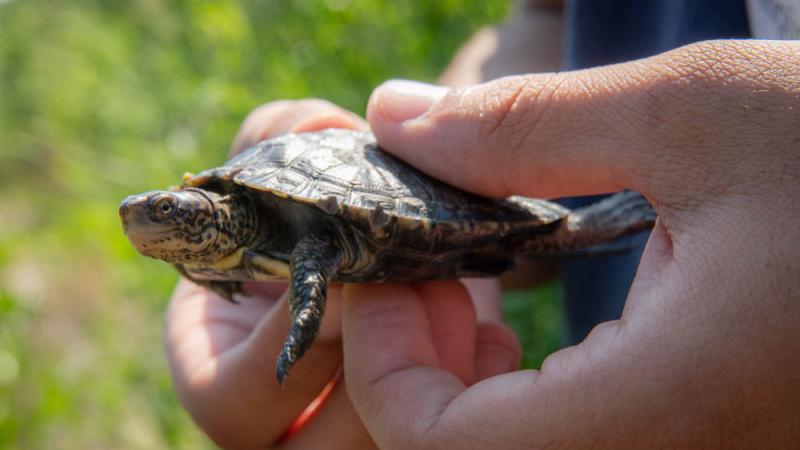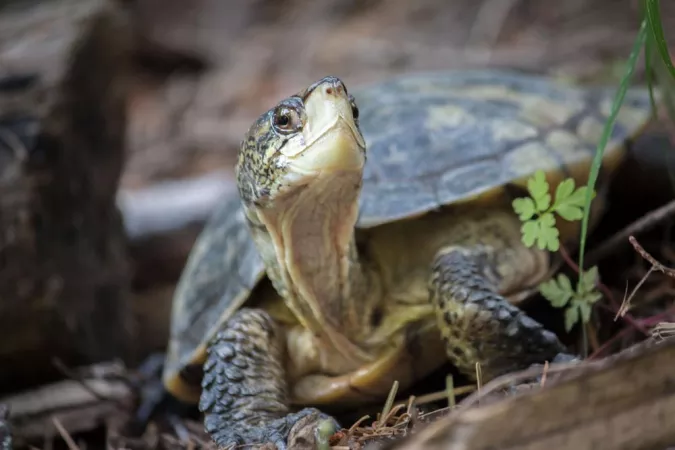Northwestern pond turtles

They survived the dinosaurs, but turtles worldwide are facing a modern extinction crisis, with half of all species at risk of disappearing.
Once common from Baja California to Puget Sound, the small, long-lived northwestern pond turtle (Actinemys marmorata) is listed as endangered in Washington and threatened in Oregon. The Oregon Zoo works with Washington Department of Fish and Wildlife (WDFW) to help restore this shy reptile to its historic range through a unique head-starting program. As a result, Western pond turtle numbers are on the rise.
Adult turtles can live up to 70 years, nest on land and feed, breed and bask in water. They prefer streams, ponds, lakes and permanent wetlands, although their populations are much reduced and concentrated in a few locations.
Threats
Habitat loss
draining and filling of wetlands, dams and water diversion deprive these aquatic reptiles of critical habitat
Shell disease
an emergent disease affecting the shell, which can lead to paralysis and death in advances stages
Invasive predators
bullfrogs and largemouth bass prey on the vulnerable hatchlings
Invasive plants
when non-native plant species dominate, turtles can't excavate a nest, and the sun can't reach their nests
Western pond turtle recovery
In 1990, work started to recover Western pond turtles in Washington. The Oregon Zoo has been a collaborator since 1998.

A "head-starting" project was initiated to protect the turtles during their most vulnerable stage of life and to accelerate their natural growth rates.
What the recovery project looks like:
- Spring: WDFW biologists survey for adult female turtles.
- Summer: Female turtles dig a nest in dry, densely packed soil. She deposits two to 11 eggs into the nest, which she then covers and abandons. Biologists locate and protect nests with wire exclosures to keep predators out. The eggs incubate naturally all summer.
- Fall: Biologists collect some of the quarter-sized hatchlings and move them to facilities such as the Oregon Zoo, where they grow and eat in a predator-free 'simulated summer' environment.
- Winter: In the wild, hatchlings become dormant in the cold. But the enhanced light and warmth at the zoo stimulates them to continue to eat and grow.
- Summer: About 10 months after their summertime hatch, zoo-reared juvenile turtles are nearly three times larger than if they had remained in the wild and survived. Now large enough to avoid being eaten by common non-native predators like bullfrogs, they are released at sites selected by WDFW.
Successes and ongoing recovery work
In 1990, only two pond turtle sites were left in Washington. Today, six populations have been established with two in Puget Sound and four in the Columbia River Gorge. During the same period, more than 1,800 turtles have been head-started and released to these sites. Studies have revealed that an estimated 95 percent of turtles released in the Columbia River Gorge survived their first year.
Currently, the Washington Department of Fish and Wildlife and partners are investigating causes and treatments for the shell disease that has affected some of Washington's western pond turtles.
The Western pond turtle recovery program is a collaboration between the Oregon Zoo, Woodland Park Zoo and the WDFW. Other partners include Bonneville Power Administration, U.S. Forest Service, Washington State Parks, US Fish and Wildlife Service, Sustainability in Prisons Projects, Larch Corrections Center and others.
Take action for native turtles
Both of Oregon's native turtles - the western pond turtle and the western painted turtle - are listed as "critical" on the state's sensitive species. Find out how to help protect native turtles and report turtle sightings.

